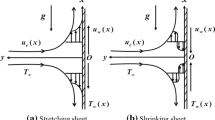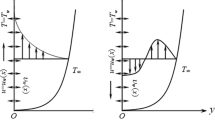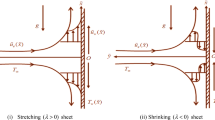Abstract
The importance of thermal efficiency in major industrial and engineering sectors cannot be overstated. Numerous processes within these domains require substantial heat transfer, and conventional fluids often fall short in generating the necessary amount of heat for these operations. Recognizing this limitation, there arose a need to enhance the thermal conductivity of ordinary liquids. In response to this challenge, researchers and scientists proposed a groundbreaking idea: the introduction of metallic and non-metallic nano additives into the base fluid to improve its thermal effectiveness. This innovative approach gave rise to a new category of liquids known as hybrid nanofluids. In this article, we delve into the analysis of the 2D steady flow of SWCNT-Fe3O4/H2O and MWCNT-Cu/H2O-based hybrid nanofluid over a stretching and shrinking sheet, taking into account factors such as suction/injection and thermophysical impacts. The utilization of similarity variables enables the reduction of partial differential equations to a more manageable system of ordinary differential equations. To solve these transformed ordinary differential equations, a numerical technique, specifically the shooting algorithm with the bvp4c solver, is employed. The results are presented and elucidated through graphical representations, providing valuable insights into the behavior of the system under consideration.








Similar content being viewed by others
Data Availability
Data will be available as per the requirement of journal guidelines.
References
Choi, S. U., & Eastman, J. A. (1995). Enhancing thermal conductivity of fluids with nanoparticles (No. ANL/MSD/CP-84938; CONF-951135–29). Argonne National Lab., IL (United States).
Mahanthesh, B., & Thriveni, K. (2021). Effects of aggregation on TiO2–ethylene glycol nano liquid over an inclined cylinder with exponential space-based heat source: A sensitivity analysis. Journal of Thermal Analysis and Calorimetry, 147, 835–1848.
Wakif, A., Chamkha, A., Thumma, T., Animasaun, I. L., & Sehaqui, R. (2020). Thermal radiation and surface roughness effects on the thermo-magneto-hydrodynamic stability of alumina–copper oxide hybrid nanofluids utilizing the generalized Buongiorno’s nanofluid model. Journal of Thermal Analysis and Calorimetry, 1–20, 1201–1220.
Farooq, U., Waqas, H., Imran, M., Albakri, A., & Muhammad, T. (2021). Numerical investigation for melting heat transport of nanofluids due to stretching surface with Cattaneo-Christov thermal model. Alexandria Engineering Journal, 61(9), 6635–6644.
Farooq, U., Waqas, H., Khan, M. I., Khan, S. U., Chu, Y. M., & Kadry, S. (2021). Thermally radioactive bioconvection flow of Carreau nanofluid with modified Cattaneo-Christov expressions and exponential space-based heat source. Alexandria Engineering Journal, 60(3), 3073–3086.
Sharma, K., & Kumar, S. (2023). Impacts of low oscillating magnetic field on ferrofluid flow over upward/downward moving rotating disk with effects of nanoparticle diameter and nanolayer. Journal of Magnetism and Magnetic Materials, 575, 170720.
Kumar, S., & Sharma, K. (2023). Entropy optimization analysis of Marangoni convective flow over a rotating disk moving vertically with an inclined magnetic field and nonuniform heat source. Heat Transfer, 52(2), 1778–1805.
Kumar, S., & Sharma, K. (2023). Impacts of Stefan blowing on Reiner-Rivlin fluid flow over moving rotating disk with chemical reaction. Arabian Journal for Science and Engineering, 48(3), 2737–2746.
Kumar, S., & Sharma, K. (2022). Mathematical modeling of MHD flow and radiative heat transfer past a moving porous rotating disk with Hall effect. Multidiscipline Modeling in Materials and Structures, 18(3), 445–458.
Sharma, K., Kumar, S., & Vijay, N. (2022). Insight into the motion of water-copper nanoparticles over a rotating disk moving upward/downward with viscous dissipation. International Journal of Modern Physics B, 36(29), 2250210.
Nadeem, S., Akhtar, S., & Abbas, N. (2020). Heat transfer of Maxwell base fluid flow of nanomaterial with MHD over a vertical moving surface. Alexandria Engineering Journal, 59(3), 1847–1856.
Naz, R., Noor, M., Hayat, T., Javed, M., & Alsaedi, A. (2020). The dynamism of magnetohydrodynamic cross nanofluid with particulars of entropy generation and gyrotactic motile microorganisms. International Communications in Heat and Mass Transfer, 110, 104431.
Rasool, G., Shafiq, A., Khan, I., Baleanu, D., Nisar, K. S., & Shahzadi, G. (2020). Entropy generation and consequences of MHD in Darcy-Forchheimer nanofluid flow bounded by non-linearly stretching surface. Symmetry, 12(4), 652.
Mabood, F., Ashwinkumar, G. P., & Sandeep, N. (2020). Simultaneous results for unsteady flow of MHD hybrid nano liquid above a flat/slandering surface. Journal of Thermal Analysis and Calorimetry, 146, 227–239.
Rasool, G., Chamkha, A. J., Muhammad, T., Shafiq, A., & Khan, I. (2020). DarcyForchheimer relation in Casson type MHD nanofluid flows over a non-linear stretching surface. Propulsion and Power Research, 9(2), 159–168.
Khan, U., Ahmed, N., & Mohyud-Din, S. T. (2017). Numerical investigation for three-dimensional squeezing flow of a nanofluid in a rotating channel with a lower stretching wall suspended by carbon nanotubes. Applied thermal engineering, 113, 1107–1117.
Waqas, H., Muhammad, T., Noreen, S., Farooq, U., & Alghamdi, M. (2021). Cattaneo-Christov heat flux and entropy generation on hybrid nanofluid flow in a nozzle of a rocket engine with melting heat transfer. Case Studies in Thermal Engineering, 28, 101504.
Farooq, U., Waqas, H., Imran, M., Alghamdi, M., & Muhammad, T. (2021). On melting heat transport and nanofluid in a nozzle of a liquid rocket engine with entropy generation. Journal of Materials Research and Technology, 14, 3059–3069.
Waqas, H., Farooq, U., Alghamdi, M., & Muhammad, T. (2021). Significance of surface catalyzed reactions in SiO2-H2O nanofluid flow through porous media. Case Studies in Thermal Engineering, 27, 101228.
Haldar, S., Mukhopadhyay, S., & Layek, G. C. (2021). Effects of thermal radiation on Eyring-Powell fluid flow and heat transfer over a power-law stretching permeable surface. International Journal for Computational Methods in Engineering Science and Mechanics, 22(5), 366–375.
Giri, S. S. (2023). Framing the features of nanolayer and diameter of carbon nanotubes in the flow of blood over a stretching cylinder in presence of magnetic induction. Numerical Heat Transfer, Part A: Applications, pp. 1–21.
Giri, S. S., Das, K., & Kundu, P. K. (2022). Computational analysis of thermal and mass transmit in a hydromagnetic hybrid nanofluid flow over a slippery curved surface. International Journal of Ambient Energy, 43(1), 6062–6070.
Giri, S. S. (2023). Outlining the features of nanoparticle diameter and solid–liquid interfacial layer and Hall current effect on a nanofluid flow configured by a slippery bent surface. Heat Transfer, 52(2), 1947–1970.
Das, K., Giri, S. S., & Kundu, P. K. (2021). Influence of Hall current effect on hybrid nanofluid flow over a slender stretching sheet with zero nanoparticle flux. Heat Transfer, 50(7), 7232–7250.
Giri, S. S., Das, K., & Kundu, P. K. (2019). Dynamics of nonuniform viscosity of unsteady CuO–H2O nanofluid flow from a spinning body. Heat Transfer—Asian Research, 48(6), 2542–2556.
Xue, Q. (2005). Model for thermal conductivity of carbon nanotube-based composites. Physica B: Condensed Matter, 368, 302–307.
Tang, H., Cao, Q., He, Z., Wang, S., Han, J., Li, T., ... & Li, X. (2020). SnO2–carbon nanotubes hybrid electron transport layer for efficient and hysteresis-free planar perovskite solar cells. Solar RRL, 4(1), 1900415
Qin, W., Chen, C., Zhou, J., & Meng, J. (2020). Synergistic effects of graphene/carbon nanotubes hybrid coating on the interfacial and mechanical properties of fiber composites. Materials, 13(6), 1457.
Gholinia, M., Hosseinzadeh, K., & Ganji, D. D. (2020). Investigation of different base fluids suspended by CNTs hybrid nanoparticles over a vertical circular cylinder with a sinusoidal radius. Case Studies in Thermal Engineering, 21, 100666.
Javanbakht, M. (2021). High-pressure phase evolution under hydrostatic pressure in a single imperfect crystal due to nanovoids. Materialia, 20, 101199.
Roy, A. M. (2021). Formation and stability of nanosized, undercooled propagating intermediate melt during β → δ phase transformation in HMX nanocrystal. Europhysics Letters, 133(5), 56001.
Arshad, M., Hussain, A., Elfasakhany, A., Gouadria, S., Awrejcewicz, J., Pawłowski, W., ... & M. Alharbi, F. (2022). The magneto-hydrodynamic flow above the exponentially stretchable surface with chemical reaction. Symmetry, 14(8), 1688
Hassan, A., Hussain, A., Arshad, M., Awrejcewicz, J., Pawlowski, W., Alharbi, F. M., & Karamti, H. (2022). Heat and mass transport analysis of MHD rotating hybrid nanofluids conveying silver and molybdenum di-sulfide nano-particles under the effect of linear and non-linear radiation. Energies, 15(17), 6269.
Arshad, M., Hussain, A., Shah, S. A. G. A., Wróblewski, P., Elkotb, M. A., Abdelmohimen, M. A., & Hassan, A. (2022). Thermal energy investigation of magneto-hydrodynamic nano-material liquid flow over a stretching sheet: Comparison of single and composite particles. Alexandria Engineering Journal, 61(12), 10453–10462.
Arshad, M., Hussain, A., Hassan, A., Karamti, H., Wroblewski, P., Khan, I., ... & Galal, A. M. (2022). Scrutinization of slip due to lateral velocity on the dynamics of engine oil conveying cupric and alumina nanoparticles subject to Coriolis force. Mathematical Problems in Engineering, 2022
Arshad, M., Karamti, H., Awrejcewicz, J., Grzelczyk, D., & Galal, A. M. (2022). Thermal transmission comparison of nanofluids over stretching surface under the influence of magnetic dield. Micromachines, 13(8), 1296.
Hassan, A., Hussain, A., Arshad, M., Gouadria, S., Awrejcewicz, J., Galal, A. M., & Eswaramoorthi, S. (2022). Insight into the significance of viscous dissipation and heat generation/absorption in magneto-hydrodynamic radiative Casson fluid flow with first-order chemical reaction. Frontiers in Physics, 10, 605.
Arshad, M., & Hassan, A. (2022). A numerical study on the hybrid nanofluid flow between a permeable rotating system. The European Physical Journal Plus, 137(10), 1126.
Dinarvand, S. (2019). Nodal/saddle stagnation-point boundary layer flow of CuO–Ag/water hybrid nanofluid: A novel hybridity model. Microsystem Technologies, 25(7), 2609–2623.
Hady, F. M., Ibrahim, F. S., Abdel-Gaied, S. M., & Eid, M. R. (2012). Radiation effect on the viscous flow of a nanofluid and heat transfer over a nonlinearly stretching sheet. Nanoscale Research Letters, 7(1), 1–13.
Eid, M. R., & Nafe, M. A. (2022). Thermal conductivity variation and heat generation effects on magneto-hybrid nanofluid flow in a porous medium with slip condition. Waves in Random and Complex Media, 32(3), 1103–1127.
Bidin, B., & Nazar, R. (2009). Numerical solution of the boundary layer flow over an exponentially stretching sheet with thermal radiation. European Journal of Scientific Research, 33, 710–717.
Ishak, A. (2011). MHD boundary layer flow due to an exponentially stretching sheet with radiation effect. Sains Malays., 40, 391–395.
Waini, I., Ishak, A., & Pop, I. (2020). Hybrid nanofluid flow induced by an exponentially shrinking sheet. Chinese Journal of Physics, 68(468), 482.
Khan, L. A., Raza, M., Mir, N. A., & Ellahi, R. (2020). Effects of different shapes of nanoparticles on peristaltic flow of MHD nanofluids filled in an asymmetric channel. Journal of Thermal Analysis and Calorimetry, 140(3), 879–890.
Mukhtar, T., Jamshed, W., Aziz, A., & Al‐ Kouz, W. (2020). Computational investigation of heat transfer in a flow subjected to magnetohydrodynamic of Maxwell nanofluid over a stretched flat sheet with thermal radiation. Numerical Methods for Partial Differential Equations
Ghosh, S., & Mukhopadhyay, S. (2020). Stability analysis for model-based study of nanofluid flow over an exponentially shrinking permeable sheet in presence of slip. Neural Computing and Applications, 32, 7201–7211.
Hafidzuddin, E. H., Nazar, R., Arifin, N. M., & Pop, I. (2016). Boundary layer flow and heat transfer over a permeable exponentially stretching/shrinking sheet with generalized slip velocity. Journal of applied fluid mechanics, 9(4), 2025–2036.
Waini, I., Ishak, A., & Pop, I. (2020). Hybrid nanofluid flow induced by an exponentially shrinking sheet. Chinese Journal of Physics, 68, 468–482.
Funding
The researchers received funding from the Deanship of Scientific Research, Taif University, for this work.
Author information
Authors and Affiliations
Contributions
Umar Farooq and Sobia Noreen: solved problem and wrote manuscript, software, simulation and plotting graphs; Muhammad Imran and Hassan Waqas: methodology verified and proof read, supervision; Shan Ali Khan and Aleena Ramzan: formal analysis, re-investigation; Nahid Fatima: re-validation and adding analysis of data; Abdul Bariq and S. K. Elagan: conceptualization.
Corresponding author
Ethics declarations
Ethics Approval
Not applicable.
Research Involving Humans and Animals Statement
None.
Informed Consent
None.
Competing Interests
The authors declare no competing interests.
Additional information
Publisher's Note
Springer Nature remains neutral with regard to jurisdictional claims in published maps and institutional affiliations.
Rights and permissions
Springer Nature or its licensor (e.g. a society or other partner) holds exclusive rights to this article under a publishing agreement with the author(s) or other rightsholder(s); author self-archiving of the accepted manuscript version of this article is solely governed by the terms of such publishing agreement and applicable law.
About this article
Cite this article
Farooq, U., Waqas, H., Bariq, A. et al. Local Similar Solution of Magnetized Hybrid Nanofluid Flow Due to Exponentially Stretching/Shrinking Sheet. BioNanoSci. 14, 368–379 (2024). https://doi.org/10.1007/s12668-023-01276-x
Accepted:
Published:
Issue Date:
DOI: https://doi.org/10.1007/s12668-023-01276-x




